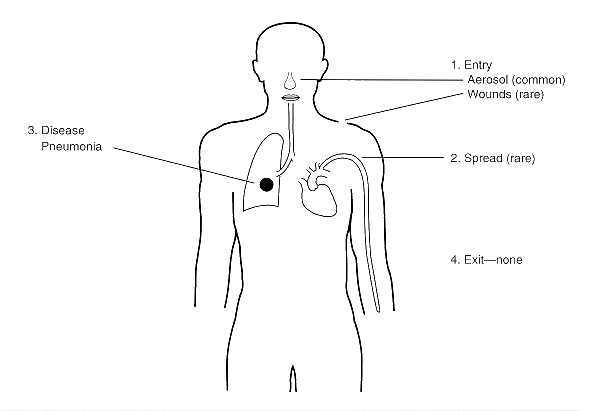Legionella: Difference between revisions
| Line 35: | Line 35: | ||
''Legionella'' do not form spores. There are two major phases to the life cycle. The first is called the replicative phase. During this period, the bacteria are nonmotile and have a low toxicity. In the second phase, called the infectious phase, the bacteria are shorter and thicker. They have developed flagella and are highly toxic. | ''Legionella'' do not form spores. There are two major phases to the life cycle. The first is called the replicative phase. During this period, the bacteria are nonmotile and have a low toxicity. In the second phase, called the infectious phase, the bacteria are shorter and thicker. They have developed flagella and are highly toxic. | ||
''Legionella'' have the capability of surviving within biofilms, particularly in man-made water systems and environments that would make extracellular growth a necessity. Evidence suggests that a majority, if not all, legionella are associated with biofilms. | |||
==Ecology== | ==Ecology== | ||
Revision as of 19:36, 8 April 2016
A Microbial Biorealm page on the genus Legionella

Classification
Higher order taxa:
Bacteria; Proteobacteria; Gammaproteobacteria; Legionellales; Legionellaceae
Species:
Legionella pneumophila, L. feeleii, L. sainthelensi
|
NCBI: Taxonomy L. pneumophila str. Paris L. pneumophila str. Lens |
Description and Significance
Legionella is related to the genus Coxiella. Legionella is best known for causing Legionnaire's disease. The bacteria are ubiquitous. Although largely aquatic, they can thrive in areas other than lakes and streams (see below). Legionella has a bad reputation because of its pathogenicity, although complete recovery from Legionnaire's is probable upon proper diagnosis.
Genome Structure
Research on the Legionella genome structure is underway. Legionella pneumophilasubsp. pneumophila str. Philadelphia 1 was completed in 2001. Plasmid pLPP of Legionella pneumophila str.Paris was completed in October of 2004; thefull genome was completed around the same time. Plasmid pLPL of Legionella pneumophila str. Lens was also complete in October of 2004, in addition to the complete genome.
Cell Structure and Metabolism

Legionella are Gram-negative. They can be rod- or coccoid-shaped. Most species are motile, and have one to three polar or lateral flagellae.
Legionella are aerobic bacteria. They use amino acids for energy. In addition, many Legionella species, such as Legionella lytica, are parasites of eukaryotic cells, and aquire energy from their hosts.
Legionella do not form spores. There are two major phases to the life cycle. The first is called the replicative phase. During this period, the bacteria are nonmotile and have a low toxicity. In the second phase, called the infectious phase, the bacteria are shorter and thicker. They have developed flagella and are highly toxic.
Legionella have the capability of surviving within biofilms, particularly in man-made water systems and environments that would make extracellular growth a necessity. Evidence suggests that a majority, if not all, legionella are associated with biofilms.
Ecology
Legionella pneumophila is the bacteria that causes Legionnaire's disease. The is a pneumonic illness. It was first discovered in Philadelphis in 1976, when it caused an outbreak of pneumonia at an American Legion Convention, infecting 221 people and killing 34. Legionnaire's disease is difficult to distinguish from any other type of pneumonia. The four major methods for diagnosis are: determination of antibody level, demonstration of the bacterium in tissues or body fluids by using immunofluorescent microscopy, actual isolation of the organism on culture media, and detection of antigenuria. If left untreated, the disease has a 5-80% mortality rate. Immunocompromised individuals are less likely to survive an infection than immunocompetent patients. Risk factors for Legionnaire's disease include: immunosuppression, cigarette smoking, renal failure, age greater than 50 years, AIDS, hematologic malignancies, and lung cancer. In addition, males are more likely to become infected with L. pneumophila than women. Alcohol abuse may be a factor, but that has not yet been determined. Legionnaire's disease is most commonly spread through aerosols. Air-conditioning cooling towers, whirlpool spas, sink taps and shower heads are all major sources for L. pneumophila. Because Legionella form symbiotic relationshiops with amebas, outbreaks of the disease are often correlated with the presence of amebas.
Other Legionella species are associated with a disease called Pontiac fever, a systemic illness. This illness was names after the place of discovery: Pontiac, Michigan. The symptoms of this disease include fever and muscle aches. It is self-contained, usually running its course in two to five days. Treatment is rarely necessary.
Legionella are often found to be intracellular pathogens of free-living protozoa and other aquatic eukaryotes which plays a major role in their virulence. The amebas provide the bacteria with an ideal environment for reproduction and development. In addition, the hosts make Legionella more resistant to adverse environmental conditions.
Legionella are aquatic organisms, inhabiting freshwater environments; humans are accidental hosts. Legionella occur in high amounts in thermally polluted water. In addition, the bacteria can be found in cooling towers, air conditioners, spa equipment, fountains, humidifiers, or showers. They can grow at a range of temperatures, anywhere from 5 to 63 degrees Celsius. However, optimal growth occurs between 25 and 40 degrees Celsius. One species, Legionella micdadei, and the ameba host, has been discovered in highly acidic geothermal environments. The parastic relationship with the host is what enable L. micdadei to survive in this environment.

References
Costa, Joana, Igor Tiago, Milton S. da Costa, and António Veríssimo. "Presence and Persistence of Legionella spp. in Groundwater." Appl Environ Microbiol. 2005 February; 71(2): 663671.
Dennis Kunkel Microscopy, Inc.
Winn, Jr., Washington C. "Legionella." Accessed 3 August 2005.
[Fields, B. S., Benson, R. F., & Besser, R. E. (2002). Legionella and Legionnaires' Disease: 25 Years of Investigation. Clinical Microbiology Reviews, 15(3), 506-526. doi:10.1128/cmr.15.3.506-526.2002]
